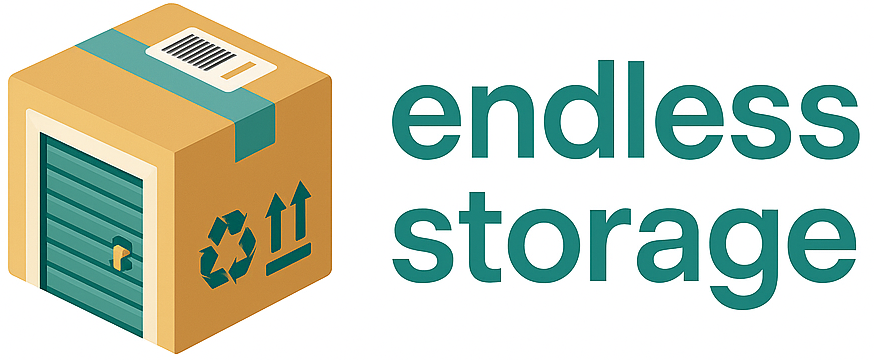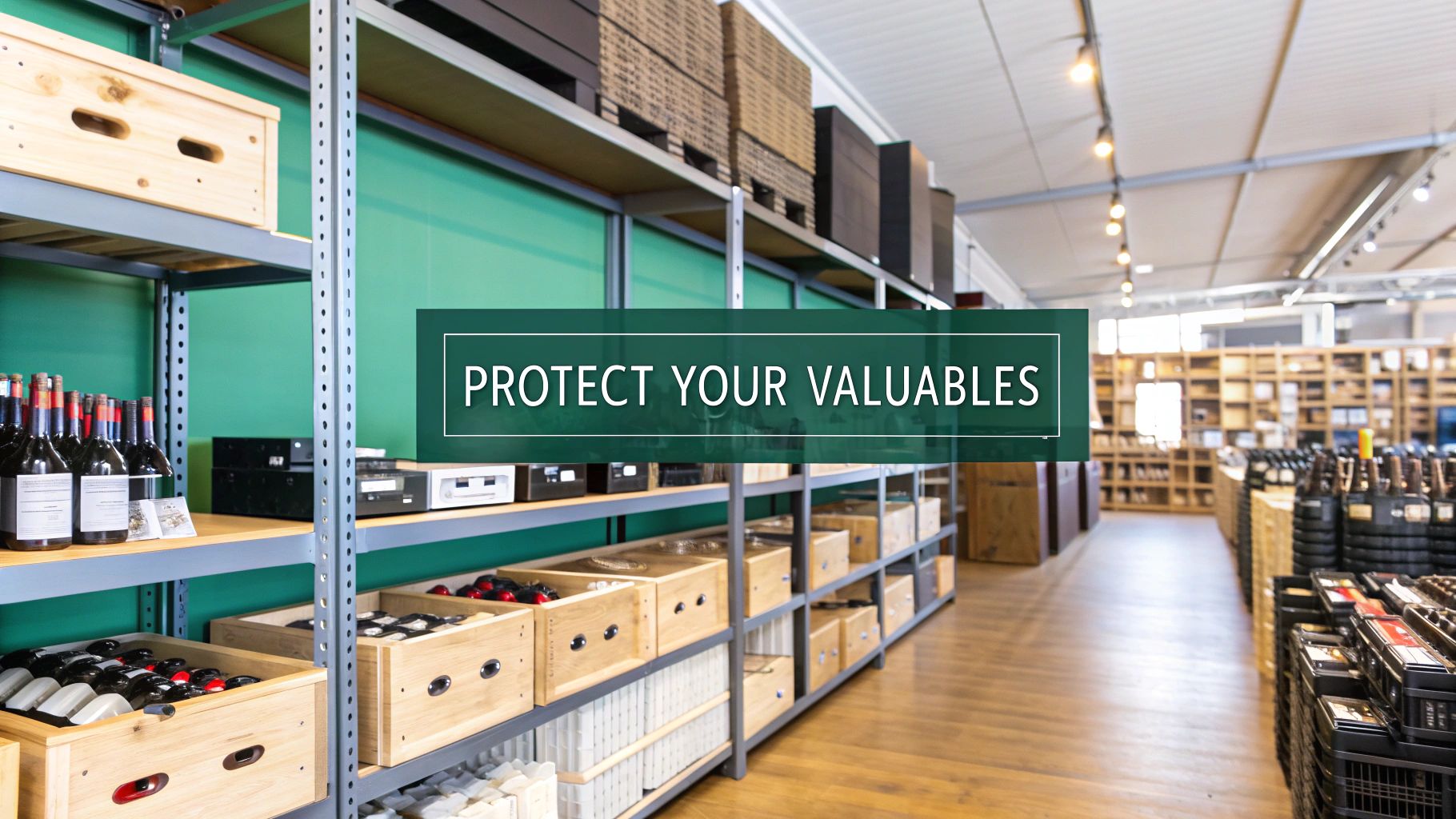You've probably heard the term climate-controlled storage, but what does it actually mean? Think of it less like a garage and more like an extension of your own home. It’s an indoor space specifically designed to maintain a consistent environment, protecting your belongings from wild temperature swings and damaging humidity.
This isn't just about keeping things out of the rain. A standard unit can expose your items to the same brutal conditions as a shed in your backyard. That kind of environment is a recipe for disaster for anything sensitive, leading to warping, mildew, rust, and cracking. Climate control is the solution that preserves the condition—and value—of your most important possessions.
Understanding the Science of Stable Storage
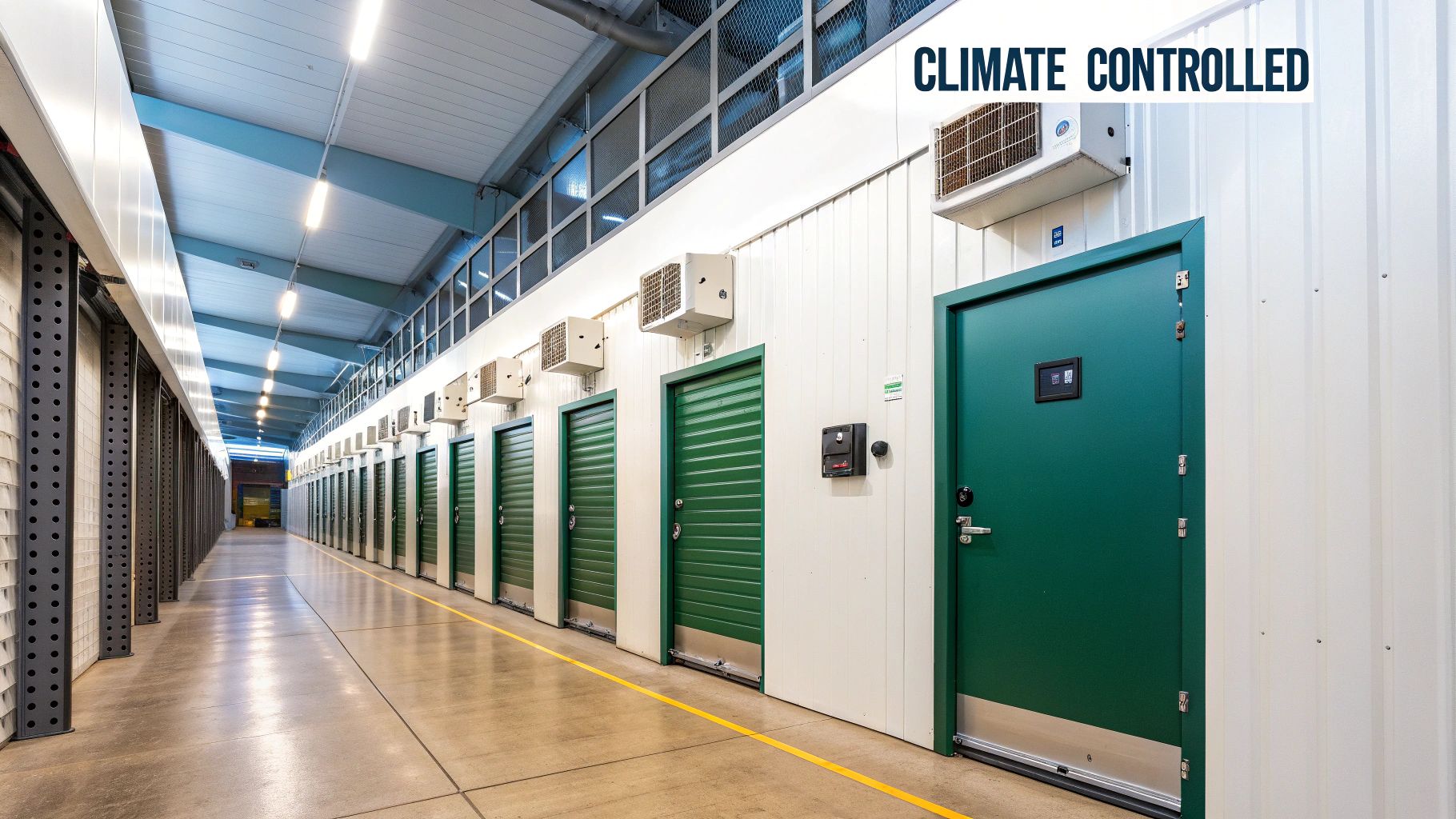
At its heart, climate control is all about managing two key factors: temperature and humidity. A typical outdoor or drive-up unit is at the mercy of the weather. On a blazing summer day, the temperature inside can easily soar past 100°F. In the winter, it can plunge below freezing. These dramatic shifts cause materials like wood, plastic, and even paper to expand and contract, which eventually leads to permanent damage.
Regulating Temperature and Humidity
Climate-controlled units tackle this problem with sophisticated HVAC (heating, ventilation, and air conditioning) systems that do more than just blast cold air. The real goal is stability. These systems work to keep the temperature within a consistent, safe range, usually between 55°F and 85°F. This prevents the destructive cycle of extreme heat and cold from ever starting.
But temperature is only half the battle. Humidity is just as important, if not more so. High humidity is the perfect breeding ground for mold and mildew, which can completely ruin fabrics, documents, electronics, and furniture. By keeping the relative humidity between 30% and 50%, these units stop moisture from building up and prevent corrosion, rot, and musty odors from taking hold.
Think of it as creating a protective bubble for your belongings. This controlled environment effectively pauses the aging and degradation that happens when things are left to the elements, ensuring they come out in the same condition you put them in.
It's no surprise that more people are seeking out this level of protection. The global market for this service was valued at roughly USD 26.27 billion and is expected to climb to over USD 38 billion by 2030. This growth is fueled by our need to safeguard everything from sensitive electronics and fine art to priceless family heirlooms.
Want to learn more about how this technology keeps your items safe? Check out our complete protection guide to climate control self-storage.
The Hidden Dangers Lurking in Standard Storage
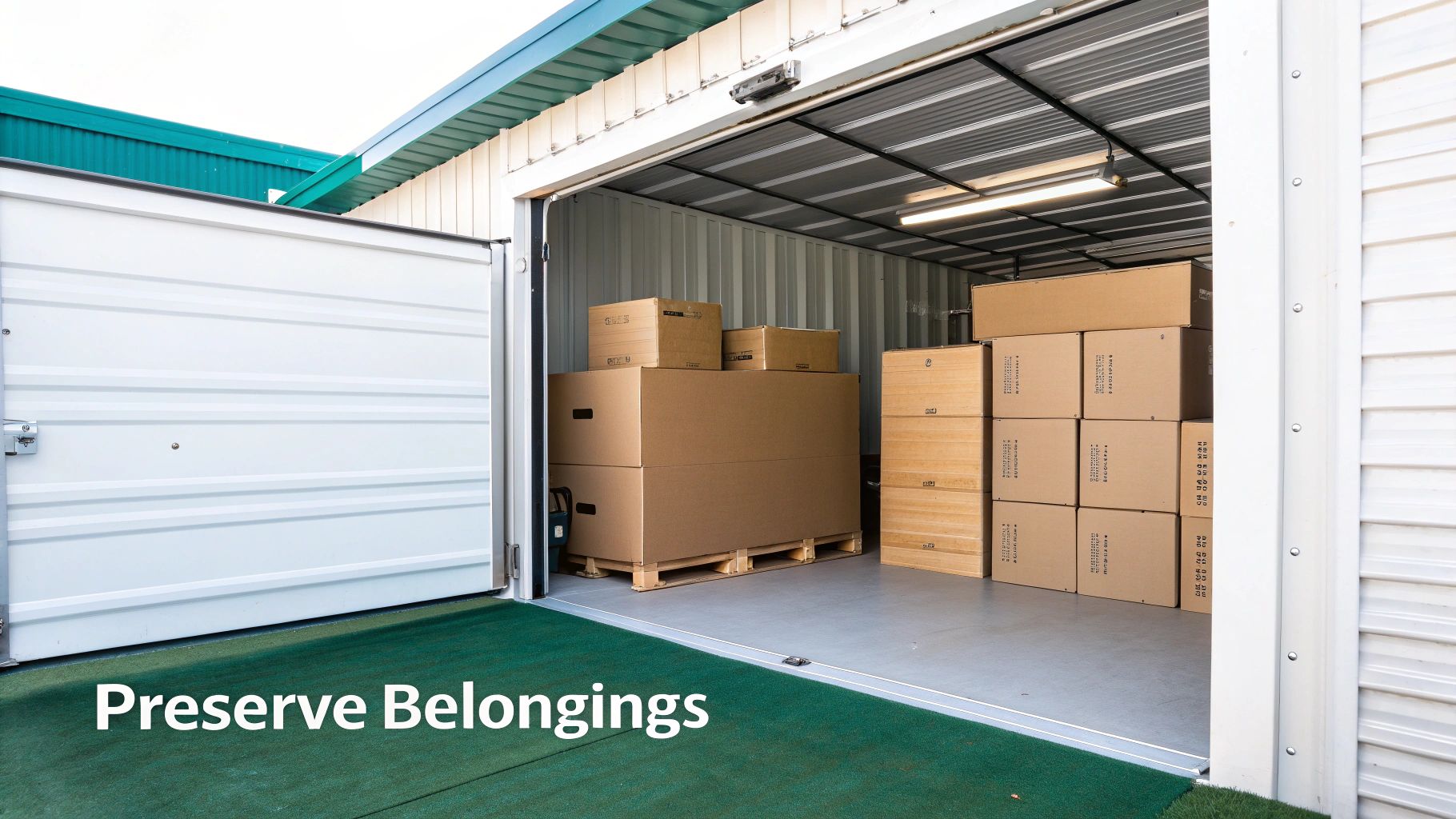
You might think a standard storage unit is just a simple, secure box. In reality, it’s a space where a quiet war is waged against your belongings every single day. These units are little more than metal sheds, directly exposed to the elements. What happens outside, happens inside. And the consequences can be slow, silent, and irreversible.
Picture your grandmother's antique wooden dresser, a cherished family heirloom. Stick it in a standard unit over a single hot, humid summer. As the moisture in the air seeps into the grain, the wood swells, popping joints and peeling that beautiful finish. Then, when the weather cools, the wood contracts—but it never goes back to its original shape. It’s left permanently warped and cracked.
This isn’t some far-fetched, worst-case scenario. It’s a common story for sensitive items stored without protection. That same humidity that destroys furniture also creates the perfect breeding ground for mold and mildew. Before you know it, they’ve infested fabrics, books, and photo albums, leaving behind permanent stains and a musty odor you’ll never forget.
The Unseen Enemies: Temperature and Humidity
Unchecked temperature swings are another silent threat. A summer heatwave can turn the inside of a unit into an oven, melting vinyl records, degrading old film negatives, and frying the delicate circuits in your electronics. Winter’s extreme cold is just as bad. It can make plastics brittle enough to snap and cause liquids to freeze, expand, and crack their containers.
These are the primary dangers that thrive in a standard storage unit:
- Mold and Mildew: High humidity is an open invitation for fungal spores to grow on wood, paper, and fabric, leading to decay you can't undo.
- Warping and Cracking: Constant expansion and contraction from temperature changes cause wood to bend, split, and lose its shape for good.
- Corrosion and Rust: Moisture in the air is a catalyst for rust, eating away at metal tools, appliances, and electronic parts.
- Yellowing and Brittleness: Important documents, family photos, and other paper goods degrade fast, turning yellow and fragile when exposed to extreme conditions.
In short, a standard storage unit puts your items through a relentless cycle of environmental stress. Without the stability of climate-controlled storage, your belongings are left vulnerable to gradual but certain destruction.
This slow decay happens out of sight. By the time you find it, the damage is often too severe to fix. Choosing the right storage isn’t just about getting more space—it's about preserving the condition and value of the things you care about most. Protecting your possessions from these hidden dangers is exactly why climate control isn’t a luxury; it’s a necessity for anything valuable or sentimental.
Key Benefits of Choosing Climate Control
Once you see what can happen to your belongings in a standard unit, the value of a stable environment becomes undeniable. Choosing climate controlled storage units isn't just a minor upgrade; it's a critical decision to protect your valuables. The biggest advantage is the defense it offers against wild temperature swings and humidity—the two primary culprits behind damage and decay.
Think about that antique wooden dresser we mentioned earlier. In a climate-controlled space, it’s safe from the soupy summer air that makes wood swell and the dry winter cold that causes it to shrink and crack. By keeping the environment consistent, these units stop that destructive cycle in its tracks, preserving the integrity and finish of your furniture for the long haul.
Preservation and Protection
This protective bubble goes way beyond just wood, though. Regulated humidity is a game-changer for preventing mold and mildew, which can absolutely ruin fabrics, upholstery, and irreplaceable documents. A steady environment provides a few other key advantages, too:
- Pest Prevention: A clean, dry, climate-controlled unit is a much less inviting home for pests like rodents and insects, which are always on the lookout for damp, dark places to hide.
- Improved Air Quality: These units typically have better air circulation than their standard counterparts. This simple feature helps keep dust and allergens from settling on your things over months or years.
- Material Stability: Sensitive items like vinyl records, old photographs, and electronics are shielded from the warping, melting, and internal corrosion that extreme heat and fluctuating temperatures can cause.
The real payoff here is peace of mind. You can store your items—whether they're sentimental keepsakes or valuable investments—and know they are protected from the elements 24/7. That kind of assurance is priceless, especially when you're storing things for a long time.
This level of care makes sure your belongings come out of storage in the exact same condition they went in. To dig a little deeper, you can learn more about the many benefits of climate controlled storage and see how it actively preserves the things you care about most.
So, when is climate-controlled storage an absolute must? The answer really comes down to what you're planning to put away. While pretty much anything you own will be happier in a stable environment, some items are just too sensitive to temperature swings and humidity to risk it with a standard unit.
We’re not just talking about expensive things, either. Often, it's the sentimental, rare, or simply irreplaceable items that need that extra layer of protection.
Think about materials like wood, leather, paper, and delicate electronics. These are the things that fall victim to the warping, mold, rust, and cracking that can happen in a typical garage-style unit. Figuring out which of your belongings fall into this category is the first step to protecting them for the long haul.
This handy guide can help you make a quick decision.

As you can see, if an item is sensitive to heat, cold, or moisture, climate control is always the safest bet for keeping it in great condition.
Electronics And Media
Your modern gadgets and old-school media are prime candidates for a climate-controlled space. The complex circuitry inside TVs, computers, and stereos is easily damaged by moisture, leading to corrosion. On the flip side, extreme cold can make plastic parts brittle enough to crack.
Your media collection faces just as many risks:
- Vinyl Records and DVDs: High heat can literally melt and warp these discs into unplayable, saucer-like shapes. Once that happens, there's no going back.
- Old Tapes and Film: Remember those VHS tapes, cassettes, and photo negatives? They degrade fast when temperatures fluctuate, causing faded images and brittle, unusable film.
Fine Furniture And Antiques
Wooden furniture, especially heirloom antiques, acts a lot like a sponge. When it’s humid, wood soaks up moisture and swells. This is what causes joints to loosen, veneers to peel, and drawers to jam. Then, when the air dries out, the wood shrinks, leading to ugly splits and cracks.
A climate-controlled storage unit is like a preservation chamber for these treasures. It slows down the aging process that harsh conditions accelerate, protecting the wood’s integrity and finish.
Leather furniture is in the same boat. Too much humidity invites mildew, while air that’s too dry will make the material stiff, brittle, and prone to cracking. You can dive deeper into the key benefits of this protective environment in our detailed guide.
Important Documents And Artwork
For anything made of paper, moisture is public enemy number one. In a damp, unregulated unit, important papers like birth certificates, financial records, and even beloved books can quickly grow mold or turn yellow and brittle. The same goes for photos, which can stick together in a humid environment and suffer irreversible damage.
Artwork is incredibly sensitive, too. The canvas on a painting can expand and shrink with temperature changes, causing the paint to flake or crack over time. Of course, protecting your art goes beyond just temperature and humidity—it’s also smart to learn the basics of how to preserve acrylic paintings for a lifetime for complete peace of mind.
To help you decide at a glance, we've put together this quick reference table.
Climate Controlled vs. Standard Storage: What to Store Where
This chart breaks down which items are best suited for each type of storage, helping you avoid costly damage by making the right choice from the start.
Choosing the right storage isn't just about finding space; it's about preserving the value and condition of your belongings for years to come.
How to Find the Right Storage Facility
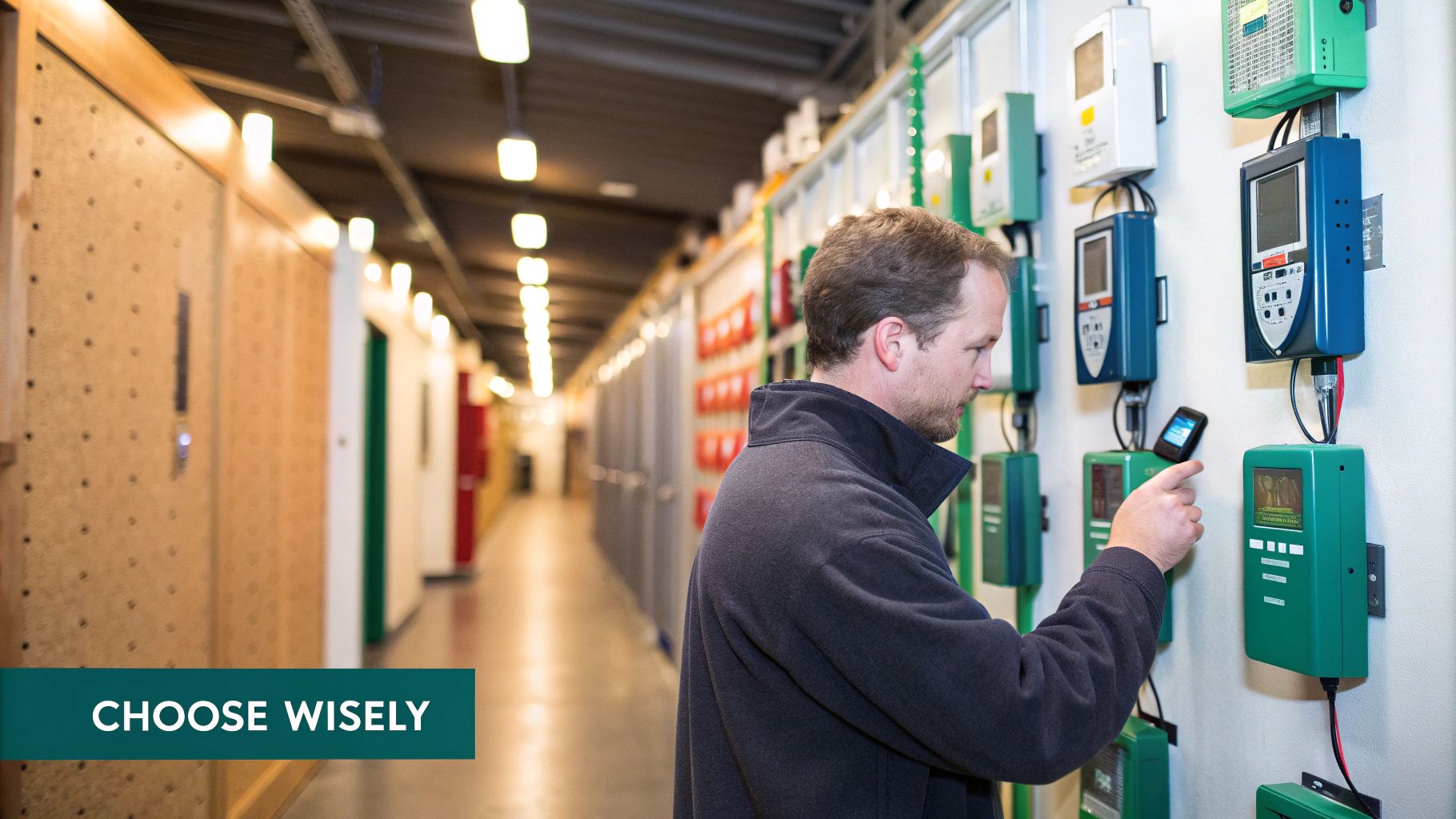
Knowing you need a climate controlled storage unit is the easy part. Now comes the real work: finding the right one. Not all facilities that advertise "climate control" deliver the same level of protection, so you'll need to do a little detective work.
Think of it less like shopping and more like conducting an interview. Your goal is to see past the monthly price and really understand the quality, security, and day-to-day reliability of the place you're trusting with your belongings.
Start by shortlisting a few local options, then get ready to ask some pointed questions. A good facility manager will have no problem giving you straight answers.
Questions to Ask the Facility Manager
Before you even think about signing a lease, you need to get clear answers on how they actually run the place. This is where you separate the pros from the amateurs.
- What is the exact temperature and humidity range you maintain? A vague "oh, it's controlled" is a red flag. You're looking for specifics, like a temperature range between 55-85°F and humidity levels kept between 30-50%.
- What are your pest control protocols? Pests can destroy sensitive items in a heartbeat. Ask how often they treat the facility and what preventative measures they have in place.
- Can you describe your security features? A single camera at the gate isn't enough. Look for a layered approach: 24/7 video surveillance, individual electronic gate access codes, and bright, well-maintained lighting.
A facility's real commitment to quality shows up in the little details. When you talk to the manager, ask about their rigorous HVAC maintenance schedule. A well-maintained system is the only thing ensuring your unit stays within that perfect temperature and humidity range.
Evaluating Security and Cleanliness
When you tour the property, trust your gut. Is the place spotless, well-lit, and free of trash? A clean property is almost always a sign of a well-managed one. Look for sturdy perimeter fences, secure-looking entry points, and visible security cameras.
Next, hit the internet and read the customer reviews. People are brutally honest online, and their experiences can tell you a lot about a facility's true colors. Look for patterns in the feedback—both good and bad—to get a realistic picture. While you want a good deal, remember that cost isn't everything. Our guide on how to find cheap storage options can help you strike the right balance between price and peace of mind.
The demand for high-quality, climate-controlled storage is skyrocketing for a reason. Market forecasts predict the self-storage industry will grow by USD 70 billion between 2025 and 2035, and a huge chunk of that is driven by specialized units like these. People are realizing their valuables are worth protecting properly. By asking the right questions and doing your homework, you can find a space that lets you store your things without a second thought.
Common Questions About Climate Controlled Storage
It’s totally normal to have a few questions, even after you’ve seen all the benefits of climate controlled storage units. Picking the right storage is a big deal, and you want to be sure you're making a smart call. Let's clear up some of the most common things people wonder about so you can feel good about your choice.
The first thing on everyone's mind is usually the price. And yes, it's true—these specialized units do cost a bit more than your standard, drive-up garage style. On average, you can expect to pay anywhere from 25% to 50% more for that extra layer of protection.
But before you let that number scare you off, think about what you're storing. If it's an antique wooden dresser, a priceless art collection, or sensitive electronics, that extra monthly cost is really an insurance policy against damage from heat, cold, and humidity. It's often a small price to pay to avoid the heartbreaking cost of replacing something irreplaceable.
Is It Necessary in a Moderate Climate
That’s a great question. You'd think climate control is only for extreme places, like the blazing Arizona desert or the swampy summers in Florida. But the truth is, even in places with "mild" weather, the temperature and humidity inside a storage unit can swing wildly.
A pleasant 75-degree day outside doesn't mean it's 75 degrees inside a sealed metal box sitting in the sun. A standard unit can still bake during the day and get chilly at night. Plus, consistent dampness—even without scorching heat—is the perfect recipe for mold and mildew to take hold over time.
Here's the key: "moderate" weather outside doesn't mean a "stable" environment inside. Climate controlled storage units aren't just about fighting extreme heat or cold; they're about creating consistency. That's something no standard unit can promise, no matter where it's located.
If you want to get into the nitty-gritty of how your local weather affects your stuff, our guide on self-storage and climate control breaks it all down by region.
What Happens During a Power Outage
This is a smart thing to ask. After all, the whole system relies on electricity. Any good storage facility has already thought this through. A short power outage, say an hour or two, isn't a huge deal—the building's insulation will keep the inside temperature pretty stable.
For anything longer, a reputable facility will have a backup plan. Most modern, quality places have backup generators on site. These are designed to fire up the second the power goes out, keeping all the essential systems running.
This includes:
- HVAC Systems: This is the big one. The generator ensures the temperature and humidity controls keep chugging along.
- Security Systems: Your belongings stay protected because the cameras, electronic gates, and alarms don't skip a beat.
- Lighting: Hallways and common areas stay lit, which is crucial for safety.
Before you sign on the dotted line, just ask the facility manager about their backup power. A place that has invested in a generator is a place that takes its "climate control" promise seriously.
What Is the Difference Between Climate and Temperature Control
You’ll often hear these terms used interchangeably, but they can mean very different things. It’s super important to know the difference so you know exactly what you’re paying for.
- Temperature-Controlled: This usually just means the unit is heated when it’s cold and cooled when it’s hot. It tackles the extreme temperatures but does absolutely nothing about the moisture in the air.
- Climate-Controlled: This is the whole shebang. These units manage both temperature and humidity, keeping them in a safe, stable range all year long.
That difference is a game-changer because humidity is often the real villain, causing mold, mildew, rust, and rot. Always ask the facility to confirm their units offer true climate control that includes dehumidification. That’s the comprehensive protection your most valuable items really need.
Ready to protect your belongings without the hassle of a traditional storage unit? At Endless Storage, we offer a modern solution with climate-controlled facilities, free shipping kits, and convenient by-the-box pricing. Secure your items with us today. https://www.endless-storage.com
Frequently Asked Questions
Unveiling the Secrets to Effortless Storage
Endless Storage is available nationwide. You pick a plan, tell us where to pickup, and we'll send a UPS van to collect, whichever state you're in.
Your shipping label will be sent to your email within a few minutes, if not instantaneously. It can also be accessed through your customer profile.
Your box will be shipped to one of our climate controlled self storage facilities in our closest self storage facility. Our manager will accept your package, notify you that your box has been received, and securely stored. Only our managers will have access to Endless Storage boxes.
Email us at admin@endless-storage.com click to live chat with us, or send us a message below.
Never! We're committed to transparent pricing with no surprises. You'll lock in your rate with no hidden fees and no long-term contracts.
Fast access guaranteed! Your boxes will arrive at your doorstep within 48 hours of requesting them back. Need to check on delivery? We provide tracking information for complete peace of mind.
Totally flexible! Store month-to-month with no long-term commitment and cancel anytime.
Everything's online! Use your account dashboard to:
• Set up automatic monthly payments
• Request box returns
• Update your address
• Order additional boxes
• Track shipments
Your boxes are insured up to $100 each. Our customer service team will help you file any necessary claims and resolve issues quickly.
Don't worry – we'll email you right away if there's a payment issue. Your items stay safe, though you may have temporary service interruption or late fees until payment is resolved.
When you request our free storage kits, you'll have 30 days to send in your boxes to activate your 3 months of free storage. Think of it like starting a gym membership – your activation window begins when you receive your kits, and your full free trial begins once you send in your first box. During your free months, you'll experience our complete storage service at no cost.
Your 30-day activation window begins when you receive your storage kits. We'll send you an email confirmation when your kits are delivered, marking the start of your activation period.
If you haven't sent any boxes for storage within your 30-day activation window, your free trial will expire and we'll begin charging the regular monthly rate of $9.99 per box. This helps ensure our storage kits go to customers who are ready to use our service.
A box costs $9.99 per month to store (plus sales tax). This price includes free shipping for standard boxes under 50 lbs. and smaller than 16"x16"x16"
Log into your Endless Storage account, locate the box you would like returned, and simply click Return My Box.
Yes, each box stored with us is insured for up to $100 throughout transit as well as the duration of storage within our facilities.
Your box will be at your doorstep within 48 hours of you requesting it back.
Store 10+ boxes? We'll pick them up for free! After your purchase, we'll contact you to schedule a convenient pickup time and arrange UPS collection.
We trust UPS with all shipments, and every box includes $100 insurance coverage. You'll receive tracking information to monitor your items' journey.
Yes! Visit any of our locations by appointment. Just bring a photo ID matching your customer profile.
For everyone's safety, we can't store hazardous materials, firearms, or perishables. All items must fit within our standard boxes.
It's easy! Order your storage kit online, and we'll ship it to you within 1-2 business days. Your shipping labels will be emailed instantly and available in your account.
We're here to help! Email us at admin@endless-storage.com, use our live chat, or send us a message through your account.
To cancel your storage service with Endless Storage, please email your cancellation request to admin@endless-storage.com. Our team will process your request within 2 business days and confirm your cancellation via email.
We understand packing takes time. However, to maintain your free trial benefits, you'll need to send at least one box within the 30-day activation window. If you need more time, you can always start with one box to activate your trial and send the rest later. You can always reach out to admin@endless-storage.com if you have any issues or concerns.
When you request our free storage kits, you're starting a 30-day window to begin using our storage service.
To avoid any charges, simply send at least one box for storage within 30 days to activate your 3-month free trial. If you decide not to use our service and don't send any boxes within the 30-day window, a one-time $50 fee will apply to cover the costs of materials and shipping. This helps ensure our storage kits go to customers who are ready to use our service.
Think of it like reserving a hotel room – we're setting aside space and sending specialized packing materials for your use. The fee only applies if you request materials but don't begin storage, similar to a hotel's no-show charge.
